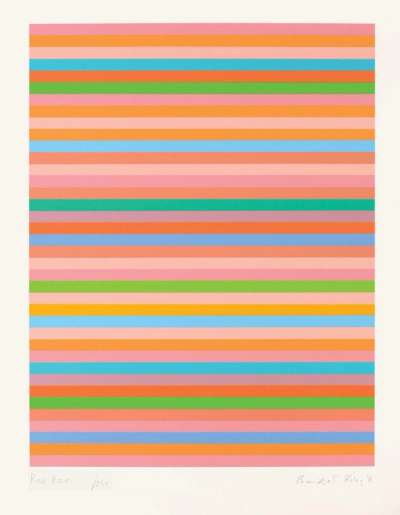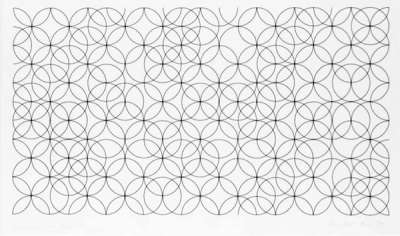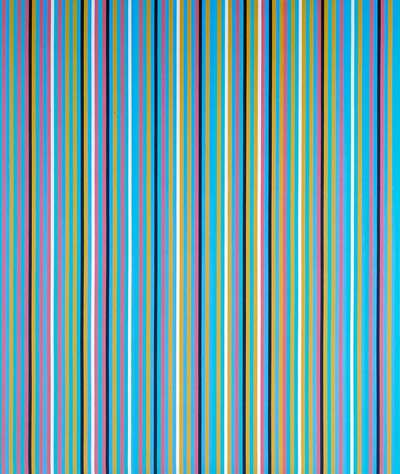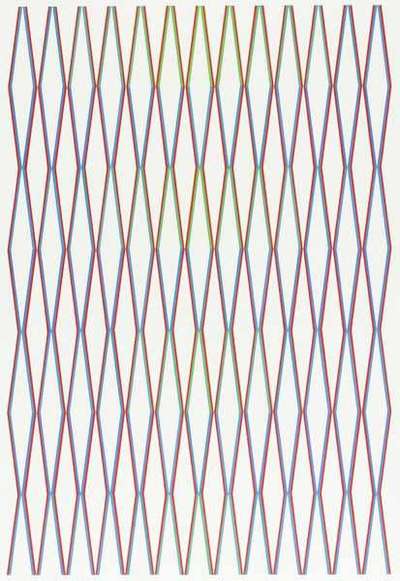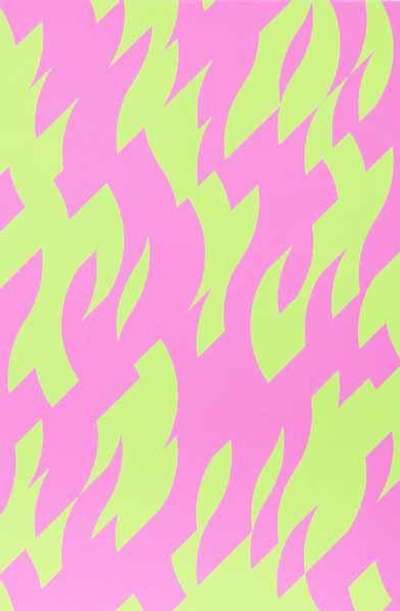Printmaking: A Staple in Bridget Riley's Art & Life

 After Rajasthan © Bridget Riley 2013
After Rajasthan © Bridget Riley 2013
Bridget Riley
111 works
In recent years, there has been a reevaluation of the importance of printmaking in Bridget Riley’s oeuvre. Their number is significantly smaller compared to paintings – a little over 100 compared to almost 700 – but they are now seen as an important appendix to her most famous pieces. They have served as companions to museum-pieces, charting her artistic evolution from her early monochromatic explorations to later vivid colour compositions. In the last sixty years, Riley has transformed the medium into an avenue for groundbreaking optical and geometric art, leaving an enduring impact on the art world and beyond.
The Beginnings: Printmaking and Riley’s Childhood
Riley's profound connection with printmaking traces its roots back to her early childhood, and is deeply entwined with her family's legacy. She was born into a lineage of printers; her father John Fisher Riley was a skilled practitioner of this craft, as was her grandfather. The family owned a printing business, which was relocated to Lincolnshire from Yorkshire in 1938. Growing up in an environment where prints and the art of creating them were a daily occurrence, Riley was continuously exposed to the intricate processes and the delicate balance of artistry and technique that printmaking requires.
This early immersion in the world of prints played a crucial role in shaping her artistic sensibilities. This childhood experience provided Riley with a deep appreciation for the medium's potential, not just as a form of artistic expression, but as a vital tool for exploring visual concepts. Thus, from the very beginning, printmaking was not merely a part of Bridget Riley's environment, but an integral part of her identity. It offered her a first language in the realm of art, a foundational influence that would later manifest in her renowned optical and geometric works. Her father's and grandfather's legacy in printmaking was more than a professional heritage – it was a gateway to Riley's future explorations and triumphs in the art world.
Evolution of Art: How Printmaking Influenced Riley's Visual Language
Riley's journey into the realm of visual art is deeply rooted in her early experiences, which profoundly influenced her distinctive visual language. The principles of colour and form, bold contrasts, rhythm, and repetition — core elements of her works — can be traced back to her family’s engagement with printmaking.
With its emphasis on the meticulous application of colour and careful consideration of form, printmaking played a pivotal role in Riley's exploration of these elements. The process of layering colours in prints, where each hue must be precisely planned and executed, allowed Riley to develop a keen sensitivity to how colours interact with each other and with the overall composition. This understanding became a cornerstone of her work, evident in the way she manipulates colour to create vibrancy and movement.
Printmaking also has an inherent nature of working with stark contrasts, especially in techniques like woodcuts or lithography, which translate seamlessly into Riley's art. Her adept use of contrast is not just in tones but also in the juxtaposition of colours and shapes. This skill became instrumental in her ability to capture and direct the viewer's eye, creating the sort of dynamic and engaging visual experiences that have come to define the Op-Art movement. Her works are full of rhythm, in which repeated patterns create a sense of motion and depth, drawing viewers into a state of optical playfulness.
As Riley experimented more and more with printmaking in her own career, the discipline required provided her with a unique vocabulary that was translated into her larger body of work. Through printmaking, she mastered the art of creating visual narratives that are both structurally disciplined and wildly imaginative.
Techniques and Styles: Understanding Riley's Printmaking Methods
Riley's printmaking technique is characterised by her dedicated and innovative use of silkscreen, a method she has predominantly employed since her first foray into the medium in 1962. Her approach reflects a deep understanding of the technique and a continuous evolution of her artistic style.
In the early 1960s, Riley's work was predominantly monochromatic, focusing on black-and-white compositions. During this period, she explored the use of gradations of grey tones, adding a subtle yet impactful layer of complexity to her work. Her choice of formal pictorial elements was confined to basic geometric shapes such as squares, circles, discs, ovals, and curves. This phase was marked by a meticulous exploration of form and contrast, laying the groundwork for her later experiments with colour and movement.
As her style evolved, the greys in Riley's work began to take on colour, transforming into a theme of their own. This transition marked a significant development in her artistic language, as hue brought a new dimension to her exploration of visual perception. The incorporation of colour was not merely an aesthetic choice but also a means to deepen the interaction between form and viewer. In the latter half of the 1960s, Riley introduced a broader palette into her prints. She restricted herself mainly to stripes, lines, diagonals, and an expanded use of curves. This shift was not just about the introduction of colour but also about its strategic application to create an increased sense of movement within her works. The way she used colour theory and geometry in tandem produced a dynamic visual rhythm, making the static image seem as if it were in motion.
Riley's mastery in silkscreen printmaking is evident in the precision and complexity of her works. Her ability to control and manipulate the medium has made her prints some of the most technically advanced and accomplished in the art world. The evolution of her style from monochrome to vibrant colour, from simple geometric forms to complex arrangements, showcases her unparalleled skill in using printmaking not just as a method of reproduction, but as its own sophisticated tool for artistic expression.
Influence and Legacy: Printmaking's Impact on Riley's Career and Beyond
Riley's engagement with printmaking has not only been a significant aspect of her artistic journey but has also left its mark on the landscape of contemporary art. Her innovative use of the silkscreen method, her evolution from monochromatic to vibrant colour schemes, and her mastery in creating dynamic visual experiences have cemented her status as a pivotal figure in the world of painting and printmaking.
Riley's prints are a testament to the potential of printmaking as a medium that transcends mere reproduction, evolving into a powerful form of artistic expression. Her work challenges the viewer's perception, inviting them to engage in a visual dialogue with the art. Her commitment to exploring and expanding the possibilities of printmaking reflects a broader narrative about the importance of experimentation, persistence, and evolution in creativity. Her career serves as an exemplar for artists, demonstrating how one can remain true to their artistic vision while continuously pushing the boundaries of their chosen medium.
Riley's contributions through painting and printmaking stand as a beacon of innovation and artistic excellence. Her influence resonates not just in her visually captivating works but also in her role as a trailblazer who expanded the horizons of what printmaking could achieve. As we reflect on Riley's impact, it is clear that her legacy will continue to inspire and shape the world of art for generations to come.










